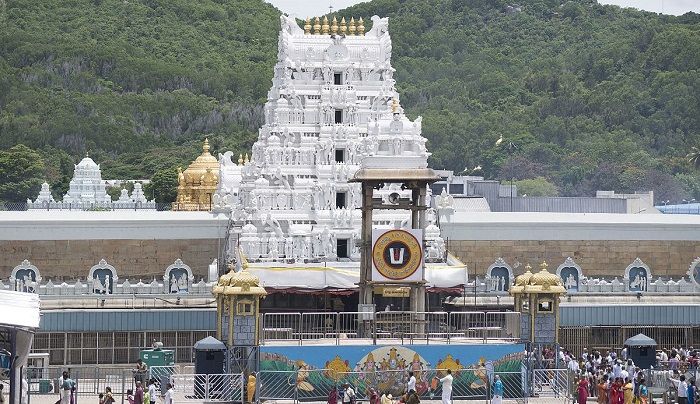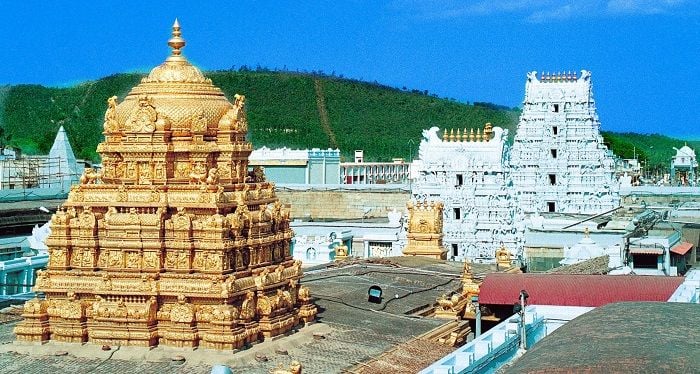
Image Credit: https://en.wikipedia.org/wiki/Venkateswara_Temple,_Tirumala
Fast Facts
Location: Chittoor, Andhra Pradesh, India
Built By: King Thondaiman
Architectural Style: Dravidian
Dedicated To: Lord Venkateswara
Tradition: Vaishnavism
Major Festivals: Brahmotsavam, Vaikunta Ekadasi
Lord Venkateswara Temple at Tirumala (Tirupati) is one of the most famous temples in India. With more than 35 million pilgrims visiting the temple every year, it is one of the most visited holy places and also one of the richest temples in the world. Built on the Venkata Hill, which is a part of the famous Seshachalam Hills, Tirupati Temple is considered as one of the holiest shrines by the Hindus. According to a legend, Lord Vishnu assumed the form of Sri Venkateswara to save mankind from the adversities of Kali Yuga.
History & Legends Associated with the Temple
There are many legends associated with the origin of this age-old temple. The larger than life statue of the main deity is said to have formed on its own, making it one of the eight ‘Swayambhu Kshetras’ (self-manifested image) of Lord Vishnu. Many ancient texts, including the Rig Veda mention the existence and prominence of the temple. Written texts, which are dated back to the Mauryan and Gupta era, refer the temple as ‘Aadhi Varaha Kshetra’. In fact, many other texts and theories link the history of Tirupati Temple to Lord Varaha, one of the ten avatars of Lord Vishnu. According to a legend, Lord Varaha created the entire Seshachalam Hills so that Adisesha, the seven-headed snake on which Vishnu rests, could rest on earth. Interestingly, Seshachalam Hills has seven peaks, which are said to be the representation of the heads of Adisesha.
As far as the construction of the temple is concerned, King Thondaiman of Tondaimandalam kingdom constructed the precincts and the towering gateway (Gopuram) of the temple. He also made sure his subjects worshipped the Lord regularly.

The construction of the temple too has many legends associated with it. One such legend has it that Lord Vishnu appeared in King Thondaiman’s dream and asked him to construct the temple. The temple was later expanded by various kings and emperors who ruled over the place. Starting from 300 AD, the Tirupati Temple was built over a period of time. One of the earliest recorded evidences state the generosity of Pallava queen Samavai; she had donated precious jewels and 23 acres of land for celebrating the major festivals of the temple. During the Chola dynasty, the temple was developed further as many Chola Kings embellished it with riches. When the Vijayanagara Empire took over, diamonds and gold were donated to the temple. Krishnadevaraya, one of the famous Emperors of Vijayanagara, visited the temple on multiple occasions and contributed to the construction of the temple.
After the decline of the Vijayanagara Empire, the temple was patronised by several kings until the advent of the East India Company. When the British took over the temple, they leased it for various purposes to different tenants. The East India Company then bestowed the administration of the temple to the chief priest of Hathiramji Muth. The Hathiramji Muth administered the temple until 1933, after which the ‘Tirumala Tirupati Devasthanam’ (TTD) took over the administration of the temple. In 1966, a court order transferred the administration of the temple to the government of Andhra Pradesh. This order was rolled back in 1979, when the administration of the temple was vested to the members of TTD. A committee, including a couple of members representing the government of Andhra Pradesh, was formed for running the day-to-day administration.
Architecture
Built in accordance with the Dravidian style of architecture, the temple has three entrances, which lead to the sanctum sanctorum. The first entrance is called as ‘Mahadwaram.’ A towering gateway (Gopuram), measuring 50 feet high, is placed right in front of the first entrance. The temple has two circumambulation paths. While the first path houses many pillared halls, flagstaffs and a dedicated area to distribute the offertories, the second path has many sub-shrines, main kitchen, main hundi and many other important edifices. Guest houses and various food counters have been recently constructed for the benefit of the pilgrims. A gold-plated tower inside the main shrine is called ‘Ananda Nilayam’ and is the most important part of the temple. The inner temple of ‘Ananda Nilayam’ houses the main deity and was constructed around the 12th Century A.D. It was later reconstructed throughout late the 1950s to 1960s. The temple also has a holy pond called Swami Pushkarni, located towards the northern side. Pushkarni, which covers a huge area of 1.5 acres, is one of the most sacred places of the temple. A legend has it that the pond was carried to the hills all the way from Vaikuntham (Lord Vishnu's abode) by Garuda. Saluva King Narasimha Raya constructed a pillared hall at the center of the pond in 1468.

Deities
There are shrines of many deities within the complex of the temple. One of them is the shrine of Lord Ram, Sita, Lakshmana and Hanuman. The temple also has shrines dedicated to Lord Krishna, along with his consort Rukmini, Vishvaksena, Sugriva and Angad. While Sugriva and Angad are prominent figures from the Hindu epic Ramayanam, Vishvaksena is Lord Vishnu’s attendant who oversees the Lord's wealth. Apart from these deities, there are five principal deities and they are mentioned below:
- Tirumala Dhruva Bera – Dhruva Bera is the main deity and is considered a source of energy. The idol of Lord Venkateswara is fixed and is believed to be a Swayambhu (self-manifested image). It is said that Lord Vishnu reincarnated on earth and assumed the form of Srinivasa (human form). During his stay on earth, he married princess Padmavati. When Goddess Lakshmi got to know about her husband’s second marriage, she went in search of him. When confronted by both Mahalakshmi and Padmavati, Lord Vishnu, who had assumed the form of Srinivasa, turns into stone.
- Bhoga Srinivasa – This is a small silver idol of the Lord which is always placed near the left foot of the main deity. This idol was donated to the temple by Queen Samavai of the Pallava dynasty in 614 A.D. The idol is usually swayed in a silver cradle and is made to sleep in a golden cot. Since the idol experiences all the worldly pleasures, it is called as Bhoga Srinivasa.

- Ugra Srinivasa – The idol of Ugra Srinivasa is kept inside the sanctum sanctorum and is cleansed everyday with holy water, milk, ghee, curd, etc. Originally, the idol was used in the processions, but was later replaced by Utsava Beram. It is said that whenever the idol of Ugra Srinivasa was taken out for processions, fire accidents would take place inevitably. Hence, this idol was considered as the fierce from of Lord Venkateswara.
- Utsava Beram – When the devotees could no longer use the idol of Ugra Srinivasa for processions, they offered their prayers to the Lord, requesting Him to suggest them an alternative. The Lord then appeared in one of His devotees’ dream and told him about another idol that can be used for processions. The devotees then found the idol of Utsava Beram in the hills of Seshachalam. The same idol is being used for processions to date.
- Koluvu Srinivasa – Made from a combination of five metals, Koluvu Srinivasa is considered as the guardian deity who supervises all the activities, including the finances of the temple. The idol closely resembles Dhruva Bera and is also called Bali Beram.

Festivals
The Tirupati Temple celebrates a staggering 433 festivals in a year, practically turning every day into a festival. Out of all those festivals, 'Brahmotsavam' is the most famous festival of Tirupati. 'Brahmotsavam' is celebrated in a grand style over a period of nine days. The festival attracts pilgrims and tourists from all over the country. According to a legend, Lord Brahma descends to earth every year in order to perform this festival and hence it is called ‘Brahmotsavam’ which literally translates to ‘the festival performed by Brahma’. Another important festival which is celebrated in the temple is called ‘Vaikunta Ekadashi.’ It is believed that the gates of heaven (Lord Vishnu’s abode) will remain open on this particular day. Hence the festival holds great significance. Other important festivals celebrated in the temple include ‘Rathasapthami’, ‘Rama Navami’, ‘Janmashtami’, ‘Vasanthotsavam’, ‘Pushpa yagam’ and ‘Teppotsavam.’
Significance
Sri Venkateswara Temple at Tirumala (Tirupati) is really significant to the Hindus from a religious point of view. Every year, the temple attracts tourists and devotees from all over the world. According to the legend, Sri Venkateswara is a benefactor of boons in the Dark Age (Kaliyuga), and people come here to seek the blessings of the Lord. Legend has it that the main deity of the temple has stood through epochs (Yugas). Since it is believed that Lord Vishnu turned Himself into stone in order to help mankind in the Dark Age, devotees often experience a state of bliss after visiting the temple. The temple also plays a vital role in the economy of the local people in general and the government of Andhra Pradesh in particular. Being the world’s richest temple, it creates job opportunities for thousands and is the only source of income to many.



